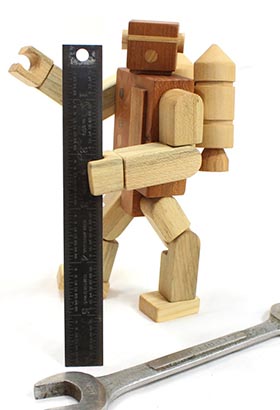The Making of a Wood Optimus Prime
How do you recreate in wood an iconic childhood toy? With a little bit of wood, some sandpaper, great attention to how close your fingers are to a sawblade, and time. Lots of time.
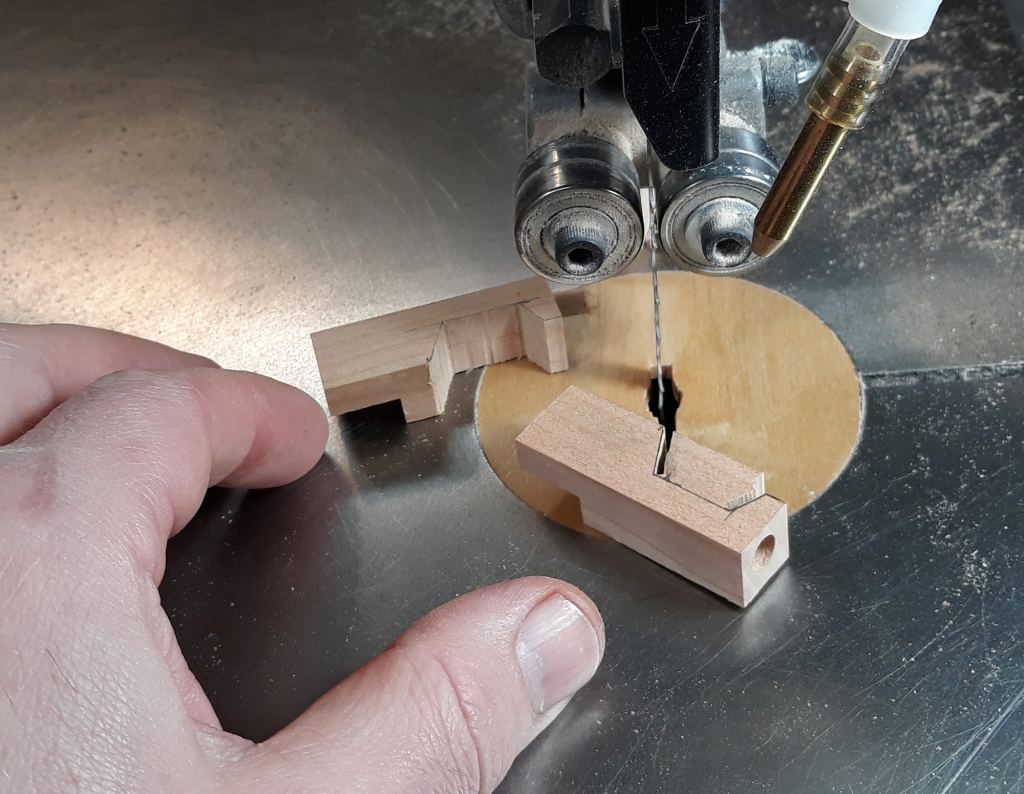
How do you recreate in wood an iconic childhood toy? With a little bit of wood, some sandpaper, great attention to how close your fingers are to a sawblade, and time. Lots of time.

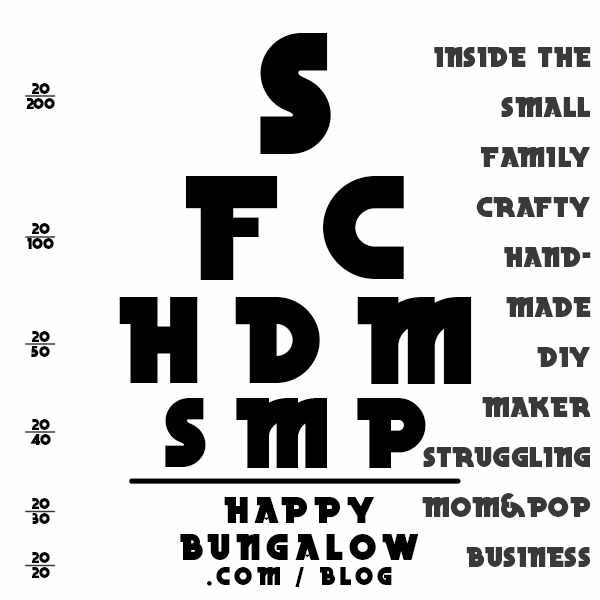
Craft shows span the spectrum from the elementary school fundraiser to the High Brow Art Faire. From the 2 hour church bazaar to the hip pop-up shop in the old hat factory. From the corporate office employee-only “farmers market” to the Crafty / Craftin’ / Handmade / Rebel / Outlaw / Misc. Profanity / Etc. Indie Art Show.
In more than four years of business I haven’t set up toy shop at every type of show, but I’ve done most of them. I’ve been out in the baking sun, in back hallways where the scant crowd didn’t even know I was there, out in the cold spring day that unexpectedly turned rain-storm, and at those beautiful shows where people are almost throwing money at me.
Read more

We resolution that running your own business is downright hard and it’s time we talk about it.
In 2016, once a month, Happy Bungalow will be pulling back the curtain on the wood shop to show what life is really like owning a small business. Well, that’s not totally accurate. Small business doesn’t quite describe us.
How about instead we call it a small / family / crafty / handmade / diy / maker / struggling / mom&pop business (further referred to as SFCHDMSMP business). We plan on showing everyone our accomplishments, just as we’ve always done, but we want to give some consideration to the struggles, disappointments, and hard work that is required to be successful (whatever that means).
Read more
We’re introducing ourselves (myself really) as though this is our first blog post, but
This is not our first blog post. We’ve been at it for four plus years now, with varying regularity. But we’ve never had a real solid plan for what we’re doing with the blog. Nor has there been contingency for how to regularly publish when we’re super busy in the shop. In the shop making toys, miniature furniture, and yeah, the best card holders east of the Ozarks.
We have a publishing schedule, and more importantly a writing schedule. As this is written in December 2015, we have half of next year’s posts penciled in and outlined. We also have all of January [nearly]ready to publish.
A bit of a warning to those living in the future who are reading backwards through our blog looking for more articles like you see in 2016 and beyond. Those articles do exist on this site before 2016, but we were still finding our blogging way, so every post isn’t a gem of internet goodness.
Boy, who’s that for a sales pitch?!
Pre-2016, most articles were written on the fly. Typically they started with the idea of selling a toy and wherever the post or story went, it went. Now though, ideas are roughed out, stories outlined, drafts revised, etc. etc. We’ll have more on this in a future blog post specifically about the business.
This post was the inspiration to create a series of upcoming stories
This was the story that inspired us to write a series of serials.
Be the first to read future articles by subscribing to one or more of our newsletters:
We have loads of toys here at the Bungalow. After all, we make wooden toys for a living. The Kids here have plenty of the same toys we sell, loads of toy prototypes, and scattered one-offs & specials too impractical to produce for sale.
And we have mass-produced, mass-marketed toys as well. We love and adore and appreciate the support of small boutique shops. They’re wonderful, sell awesome stuff that’s just about impossible to find anywhere else. And the people working the shop are terrific passionate people. But . . .
But they don’t sell Barbies. Or Strawberry Shortcake. Or Lights and Sirens On! Firetrucks. And Legos. We have loads of fun with Legos around here. Sure, the wooden toy maker’s kids have plastic toys. Sure, we’ve heard the arguments against these sort of toys. Overseas labor, bad for the environment, durability, etc. And while there are valid points to be made, the world is a complicated and cruel place. We haven’t seen the absolute rule that serves the best interests of the global community.
Mass-produced doesn’t have to mean cheap, and if you take care of the toys, they can hang around for a good while (of course we’re the biggest fans of quality handmade wooden toys – it’s just hard to hand carve a wooden doll that looks just like the ones on the television).
We are firm in having no pretend dangerous toys. We have no toys guns, knives, or swords (as if kids didn’t pretend every stick was a gun or sword anyway). And we certainly don’t endorse toy tools! Last year a gift toy chainsaw spent all of two minutes in the house. Our woodshop is in our basement, and while it’s safely behind a locked door we educate our kids on the dangers of these tools. It’s a hard and fast rule that tools are not toys. There are three saws in our shop that will cut off a hand just as easily as they cut wood. So we want none of our children in the habit of regarding any saw as a toy.
We’re comfortable with some mass-produced toys, but too many are groan inducing.
Like the countless primary-colored, battery-required, insanity-generating models. Especially tiresome are the “educational toys”. I’m pretty sure we’ve never bought one, but they show up here none-the-less (sort of like the dolls and trucks I swear are self-replicating). But you know those “learning toys” that “teach” shapes and colors. And the A, B, and C. Because all you really need in life are three letters.
I suppose one or two of these fellas wouldn’t be so bad, but after a few dozen of the battery hungry monsters accumulate . . .
The packages tout their benefits. Letter recognition. Color recognition. Hand/eye coordination. They’ll improve thinking skills and boost creativity. A greater understanding of math and geometry. Perhaps they’ll increase your child’s IQ. Good grief! Read enough of it and you’d think that singing light-up helicopter will have your kid solving algebra problems in kindergarten.
Even the non-battery operated toys tout their giftedness. We have a fun little block set that promotes color recognition and hand/eye coordination. Doesn’t picking wildflowers do the same thing?
You want a child to learn something? Teach them. Read to them. Once they learn to read on their own, buy them books. And paper. Pencils. Crayons and markers. Get em a cheap camera. Let em loose in the backyard, in the park, go explore your local urban environ. They’ll learn a ton, and I bet they’ll have fun doing it.
You want a child to have fun? Give them a toy. Make a toy with them. Play with them. Before long little worlds will be born and flourish. Great tales will be written by you and your child. You’ll both have a ton of fun, and I bet you’ll learn something while doing it.
We’ve been making a lot of stars lately. Hundreds and hundreds of stars; which is awesome because someone is paying us to make stuff! How much cooler of a job can you have? But, as we’re making hundreds at a time, it’s best to be efficient at it.
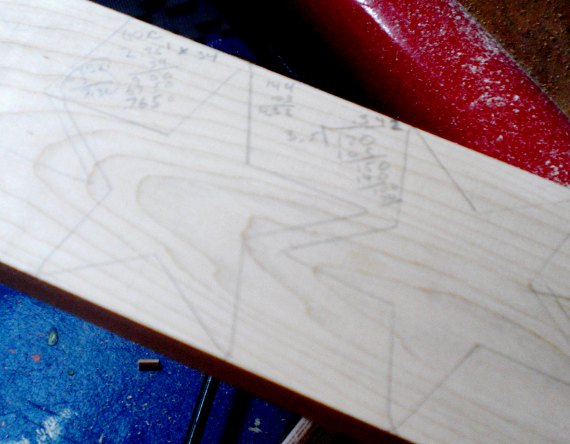 So the stars are laid out on the wood before cutting (no, even though I’ve cut more than a thousand stars, I can’t cut them from memory). So I laid out a few stars and then measured to see how many stars would fit onto so many feet of board. It’s something like a word problem:
So the stars are laid out on the wood before cutting (no, even though I’ve cut more than a thousand stars, I can’t cut them from memory). So I laid out a few stars and then measured to see how many stars would fit onto so many feet of board. It’s something like a word problem:
Don has to make 100 stars. If 7 stars fit onto 1.8 feet of maple board, how many feet of board will he need to make 100 stars? (assuming no knots or other defects in the wood that would have to be cut out)
Except there’s no calculator in the shop – only old fashioned long-hand math.
I also figured up how many square inches of wood each star used – this told me my raw materiel cost for each piece.
So yes, math is important. I don’t use calculus in the shop very often, but geometry and algebra are very important. Kids! Pay attention in math class! Don’t end up being the person that needs a calculator to double check his 7 + 7 math.
As a side-diversion:
Before I made toys, I was an architect (technically I still am, I just haven’t done any for-hire work in a while now). The number one response when telling a stranger I’m architect: “You must be good at math.”
Well, I am good at math, I think it’s fun – like solving a puzzle – but surprisingly to most people great math skills aren’t essential to architecture. Basic geometry and a little algebra is all you really need to be competent. A high-schooler would be able to handle most of the math work.
So what’s the number one skill essential to being an architect? Working an unspeakable number of thankless (and unpaid) hours.
As a toy-maker at Happy Bungalow I work more hours, but they are the opposite of thankless. I have fun every day, almost without pause. I mean come on! We’re making toys here. My job is to make toys!
Stop into our online toy shop to take home some of our work.
Well, I don’t know just how many steps there are, but I bet I’m close. We make our toy cars and trucks like any other toy we make: Quizzing The Kids about what they’d like to see in a new toy. Then come some sketches which they usually don’t understand, but are enthusiastic to support. Next comes some hand-drafted drawings (see picture below) and the first round of prototypes which The Kids understand well.
( You can see the first prototypes in the picture below in the center towards the top of the drafting board. )
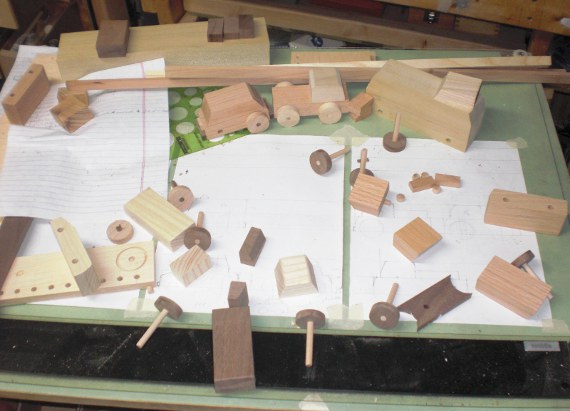
So the Kids play with the prototype cars for a while and then we hold a panel review session. It goes something like this:
Me: “What would you say you like most about this product?”
The Kids: “They’re great! Too cool!”
Me: “What would you say you like least about this product?”
The Kids: “They’re great! Too cool!”
This feedback really helps to inflate my ego and solidify my position as Most Awesome Dad.
I play with The Kids, see what other toys are invited to play with the new group, and keep an eye out for rough play that might reveal weaknesses. Then I take the toys back to the shop for simulated play and abusive testing. Weaknesses are corrected and the design/look of the toy is usually tweaked.
Then it’s on to figuring out how I’m going to build these things. It’s one thing to build a one off toy for the fun of it, it’s another thing to make quality toys for a price people are willing to pay. It’s a long process and quickly drifts into the weeds of specifics . . .
 . . . so we’ll shorten it up a bit . . . a stack of wood is planed, cut, sawn, cut, sawn, and cut again. And here at the Bungalow we use hardwoods – not a 2×4 (aka pine, spruce, or fir). These cars are made from red oak, ash, walnut, and hickory. Tough enough to be played with by three year old boys and strong enough to survive a random gnawing by a little brother.
. . . so we’ll shorten it up a bit . . . a stack of wood is planed, cut, sawn, cut, sawn, and cut again. And here at the Bungalow we use hardwoods – not a 2×4 (aka pine, spruce, or fir). These cars are made from red oak, ash, walnut, and hickory. Tough enough to be played with by three year old boys and strong enough to survive a random gnawing by a little brother.
Once all the piece are cut, they’re neatly stacked (see above). All the cars have a base and a top, are the same width, mostly the same length, and are all cut with complementary angles. Every car gets two holes drilled for axles (see below) and one small hole on the bottom where the tow truck can hook onto. I use a custom-made adjustable jig for all the drilling.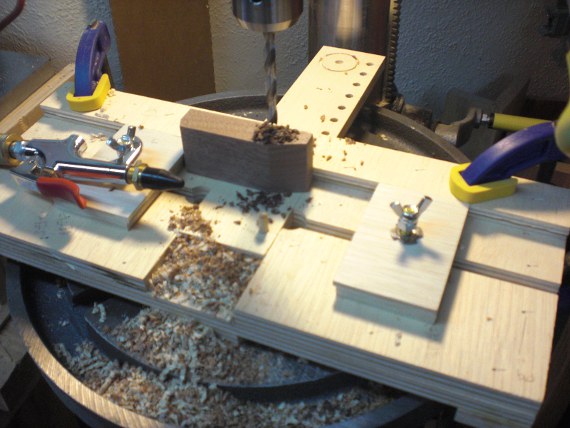 This operations piles up the saw dust – I depend on my compressed air hose to keep the work-surface clear. I drill and drill and drill and drill. You might think drilling holes for an hour or more is boring – but you’re wrong. I get to sit on a stool while I do it. It’s hard to be bored in the shop when you’re feet are happy.
This operations piles up the saw dust – I depend on my compressed air hose to keep the work-surface clear. I drill and drill and drill and drill. You might think drilling holes for an hour or more is boring – but you’re wrong. I get to sit on a stool while I do it. It’s hard to be bored in the shop when you’re feet are happy.
All Happy Bungalow cars are equipped with Strong Ox tires, mfg. Cincinnati, Ohio. They’re cut with a special hole saw. The wheels are made from walnut, unlike most wood toy cars you see which are made from a lighter toned wood (maple or beech) and look suspiciously similar. Our axles are cut from walnut dowels.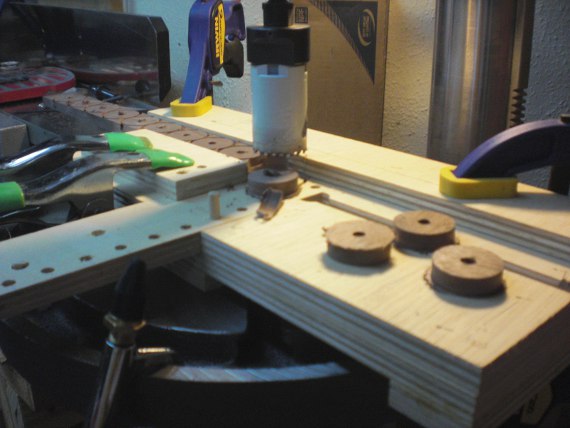 By now there’s a stack of car parts that need gluing, sanding, gluing, sanding, sanding, a smidge more sanding, and finally some natural wax finishing. I use power sanders, but a lot of the sanding work is done by hand. All corners are smoothed over – no sharp edges are left to pester little hands. I cringe to say this, because it sounds like some lame marketing line, but I do pride myself on craftsmanship. Well made, well detailed, and finely finished.
By now there’s a stack of car parts that need gluing, sanding, gluing, sanding, sanding, a smidge more sanding, and finally some natural wax finishing. I use power sanders, but a lot of the sanding work is done by hand. All corners are smoothed over – no sharp edges are left to pester little hands. I cringe to say this, because it sounds like some lame marketing line, but I do pride myself on craftsmanship. Well made, well detailed, and finely finished.
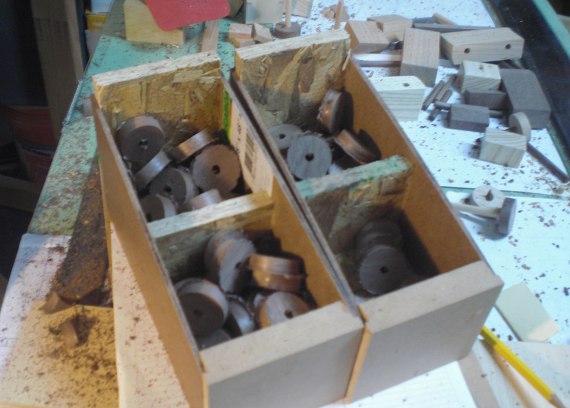 See the end results here. And take home your own car from our shop here.
See the end results here. And take home your own car from our shop here.
How is that cute kid-friendly dollhouse furniture made? Not with stained basswood. All of Happy Bungalow’s colors are natural wood.
Miniature wood furniture starts with big pieces of wood. From left to right in the picture there’s hickory, red oak, maple, and walnut.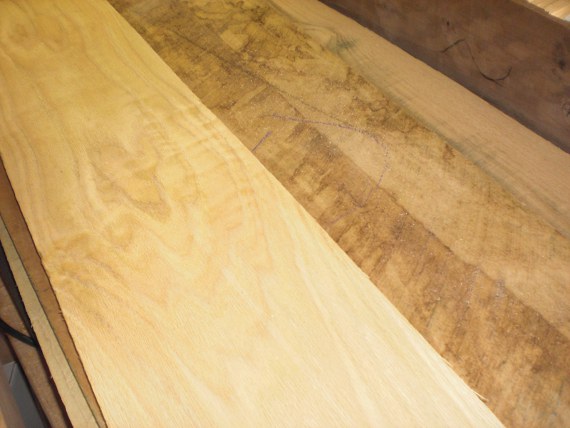 I joint and plane the boards smooth then slice the wood into thin pieces on the table saw with a shop-built resaw fence.
I joint and plane the boards smooth then slice the wood into thin pieces on the table saw with a shop-built resaw fence.
It takes several passes to slice the boards leaving the wood a bit jagged along the cut. The new thin slices of wood are smoothed on a planer and thickness sander. Smaller pieces of wood are made even smaller on the table saw (ripping the wood into thin strips) and miter saw (cutting strips into short pieces). After some sanding they’re sorted and ready for assembly. In the center of the picture you can see my full size drawings for these 1/12th size pieces of furniture.
Smaller pieces of wood are made even smaller on the table saw (ripping the wood into thin strips) and miter saw (cutting strips into short pieces). After some sanding they’re sorted and ready for assembly. In the center of the picture you can see my full size drawings for these 1/12th size pieces of furniture. 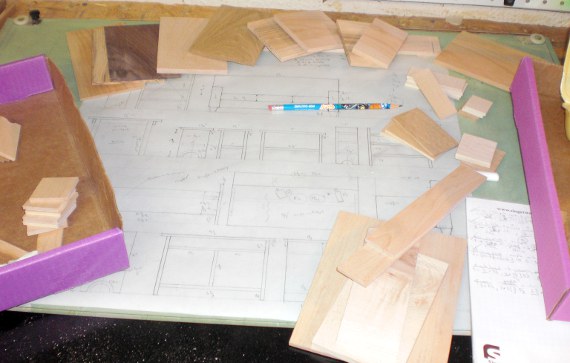 Below are some dining chairs during glue up. In the background are their companion tables. Half the chore at this stage is keeping all the pieces organized. The rest of the process is patience and a steady hand.
Below are some dining chairs during glue up. In the background are their companion tables. Half the chore at this stage is keeping all the pieces organized. The rest of the process is patience and a steady hand.
Full size clamps employed to hold together some shelves while the glue dries. I’m also a big fan of masking tape for clamping.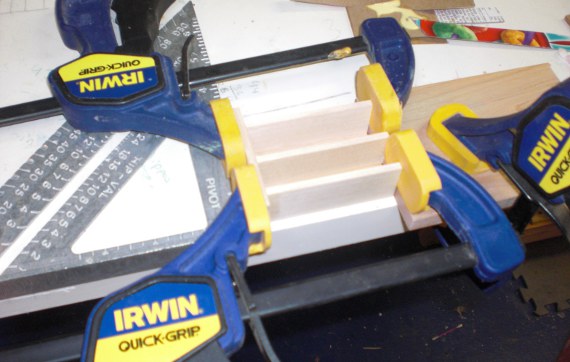
Beds, tables, chairs, and shelves are ready for finishing. 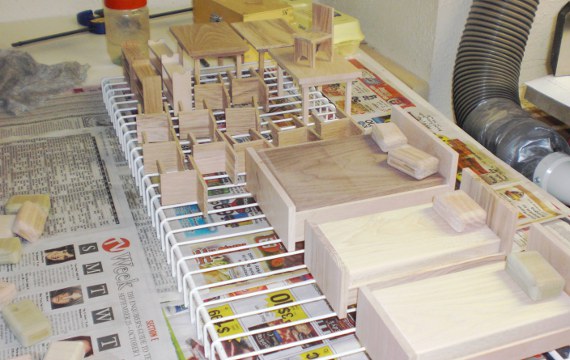
Post finishing with linseed oil the grain and texture of the wood pops.
